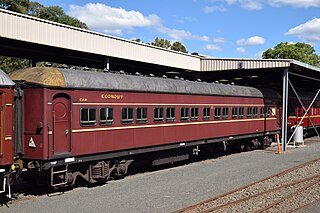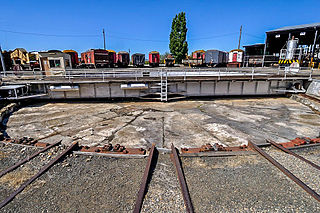
Interail was an Australian rail freight operator owned by QR National. In June 2011 it ceased trading as a separate brand, and became part of QR National.

The 620/720 class railcars were a class of diesel multiple unit built by the New South Wales Government Railways and operated from 1961 until 2007.

East Coast Heritage Rail is a not for profit company limited by guarantee formed in June 1985 as 3801 Limited to operate steam locomotive 3801 and its associated rolling stock. The company operated heritage train tours from 1986 until 2017, with operations recommencing in February 2019 under the new brand, East Coast Heritage Rail.

The 45 class are a class of diesel-electric locomotives built by AE Goodwin, Auburn for the New South Wales Department of Railways between 1962 and 1964.

The New South Wales 42 class was a class of diesel locomotives built by Clyde Engineering, Granville for the New South Wales Department of Railways in 1955/56.

The 421 class are a class of diesel locomotives built by Clyde Engineering, Granville for the Department of Railways New South Wales in 1965/66. These mainline locomotives were a follow on from the 42 class. The 421s retained the classic bulldog nose as with the other Clyde built GM and S locomotives at one end, but featured a flat-cab at the other end. In this respect, they are unique amongst bulldog nose locomotives in the world.

The 47 class are a class of diesel-electric locomotives built by A Goninan & Co for the Public Transport Commission in 1972–1973.

The 48 Class is a class of diesel locomotives built by AE Goodwin, Auburn for the New South Wales Department of Railways between 1959 and 1970. Once the most ubiquitous locomotive in New South Wales, Australia, it is based on Alco frames and prime movers, using General Electric electrical equipment. The South Australian Railways 830 and Silverton Rail 48s classes are of a very similar design.

The Gwabegar railway line is a railway line in the Central West and North West Slopes of New South Wales, Australia, which passes through the towns of Mudgee, Gulgong, Dunedoo, Coonabarabran and terminates at Gwabegar.

The Blayney–Demondrille railway line is a railway line in New South Wales, Australia. The line is used mainly for grain haulage and is owned by the Transport Asset Holding Entity, a government department of Transport for NSW. However, in 2004 the Australian Rail Track Corporation became responsible for operations over the line. The Lachlan Valley Railway operated heritage and tourist trains over the line, based at Cowra. It previously also operated general goods trains.

Independent Rail of Australia was an accredited railway freight operator in New South Wales, Australia.

Harden railway station is a heritage-listed railway station located on the Main South line in New South Wales, Australia. It serves the town of Harden. It was added to the New South Wales State Heritage Register on 2 April 1999.

3237 is a preserved former New South Wales Government Railways C32 class steam locomotive. Built in 1893 by Beyer, Peacock & Company, England, it is preserved by the Lachlan Valley Railway.

The Eugowra railway line is a closed railway line in New South Wales, Australia. The 80 km (50 mi) branch line joins the Blayney–Demondrille line at Cowra.

Locomotive 5917 is a two-cylinder, simple, non-condensing, superheated, coal-fired, 2-8-2 ‘Mikado' steam locomotive and one of five D59 class locomotives that were preserved. As of June 2021, it is the main steam locomotive used for the Picnic Train, mainly running between Sydney and Kiama.

The Junee Railway Workshop is an accredited rail operator that maintains and repairs locomotives and rolling stock from its base at Junee Locomotive Depot.

The S type carriage stock was a type of steel passenger carriage operated by the New South Wales Government Railways from 1935 until 1989.

The Goulburn Rail Heritage Centre is located at the heritage-listed former railway workshops in Goulburn, New South Wales, Australia, on the Main Southern railway line. Now a museum, it is also known as the Goulburn Rail Workshop and Goulburn Roundhouse. The workshops were added to the New South Wales State Heritage Register on 2 April 1999. The workshops were saved from demolition by the Goulburn Locomotive Roundhouse Preservation Society and is now a museum open to the public with large collection of rolling stock and various exhibits, as well as privately owned locomotives and carriages with some commercial repair work happening on site.
The D9 class were a class of diesel locomotives built by English Electric, Rocklea for Australian Iron & Steel's, Port Kembla steelworks between 1956 and 1960.

Blayney railway station is a heritage-listed railway station on the Main Western line in Blayney, Blayney Shire, New South Wales, Australia. The property was added to the New South Wales State Heritage Register on 2 April 1999.























